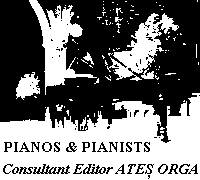 |
PIANOLA TO REPRODUCING PIANO: 2
A Plaine and Easie Introduction
|
Automania Ancient
Automatic keyboard instruments and organs (typically of the barrel-and-pin
variety) have a long history. Henry VIII had 'a Virginal that goethe
with a wheele without playing uppon'. In 1599 his daughter Elizabeth I sent
a mechanical Organ-Carrilon to Mahomet III, the Ottoman Sultan. And
during the early 19th century there was the barrel-and-pin London Street
Piano, later popular in Italy. By 1825 Clementi & Collard had made
a Self-acting Pianoforte. This combined a normal piano with
'a horizontal cylinder similar to that of a barrel-organ and set into motion
by a steel spring [of 30 minutes duration before rewinding, capable of playing]
the most intricate and difficult compositions': 'the time in which it executes
any movement may be accelerated or retarded at pleasure ... piano
and forte passages are given with correctness and effect... ' Ideal
for 'a person totally unacquainted with music, a child or a servant, [to]
perform, in the very best and most correct style', the Cylindrichord
was considered 'an admirable and efficient substitute for a first-rate performer
on the pianoforte... This instrument is extremely simple and differs altogether
from the [pinned] barrel or self-playing pianoforte; it can be accommodated
to the height or dimensions of any pianoforte, and when not in use for that
purpose, forms a piece of elegant furniture'. Shown at the 1851 Great Exhibition,
the French Antiphonel (1846) was a key-top mechanical player that
came in several forms.
Pioneering Pneumatics
Pneumatic power to drive the keyboard or piano action (a spin-off from
the English organ pneumatic lever, adopted by Cavaillé-Coll in 1837),
was a later 19th century initiative. Originally using 'perforated [stiff]
cards with square or oblong holes according to the length of the notes to
be played', the Autophon was invented in France in 1842; followed
in 1846 by a London patent for a 'perforated note sheet' (organ roll). In
1876 a French Pianista (patented in 1863) was shown at the Philadelphia
Centennial Exhibition, and enjoyed commercial success. The pianista was
an external 'push up' cabinet apparatus with a barrel, bellows and felted
wooden levers or 'fingers', powered by turning a handle. It had limited
musicality. Depending on how quickly or slowly you turned the handle, the
music sounded either fast and loud or slow and quiet. The first pneumatic
self-playing piano (39-note keyboard) was built in America in 1880, with
an 'inner player' two years later (46-note), and an electrically-powered
model in 1888 (65-note).
Automania Modern
A sophistication of the pianista method came in 1896 with the invention
of the foot-treadled (later electric pumped) pneumatic Pianola in
America. This took the form of an external 'push-up' apparatus taken to
any ordinary, unmodified piano keyboard. Later the mechanism was incorporated
internally within the instrument. [February 5th issue]
Pianola rolls were usually of the 44 or 65-note variety, with the full 88-note
range introduced from 1908. Developed and aggressively marketed as a registered
trade-name by the Aeolian Company of New York (manufacturers of the table
organette), the pianola caught the imagination of America. No self-respecting
household was without one. It was fun and it promised everything, even,
if you were gullible enough to believe the advertising hype, technique.
'It plays any piano. Any one can play it,' went the slogan. And the fact
that the basic, blue-print note rolls allowed the operator to individualise
the 'expression, tempo, touch and tone colouring' of any performance was
an appealing selling point. The false sense of artistic achievement it gave
was compounded by widely available rollographies comprising tens of thousands
of classical, popular, dance and song titles. In Europe, too, the novelty
took off, with Pleyel Wolf Lyon in Paris and Hupfeld in Leipzig (the largest
mechanical intrument factory in Europe) enjoying brisk business. The pianola,
like the car and hi-fi, was seen socially as a sexist symbol. 'Conventional
pianos,' Cyril Ehrlich has chronicled, 'were coveted for solidity and prestige,
but they were bought for women: in America, even more than in England, playing
the piano was a pastime for females and foreigners. The [mechanics of the]
pianola appealed directly to men, in addition to embodying all the attributes
of its predecessor'.
Continue >>
© Ates Orga February 12th 1999
|